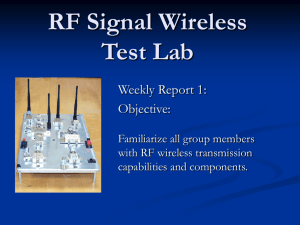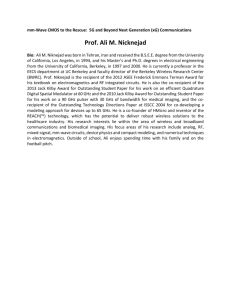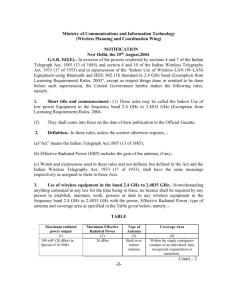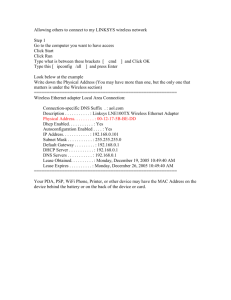Wireless Communications and Networks
advertisement
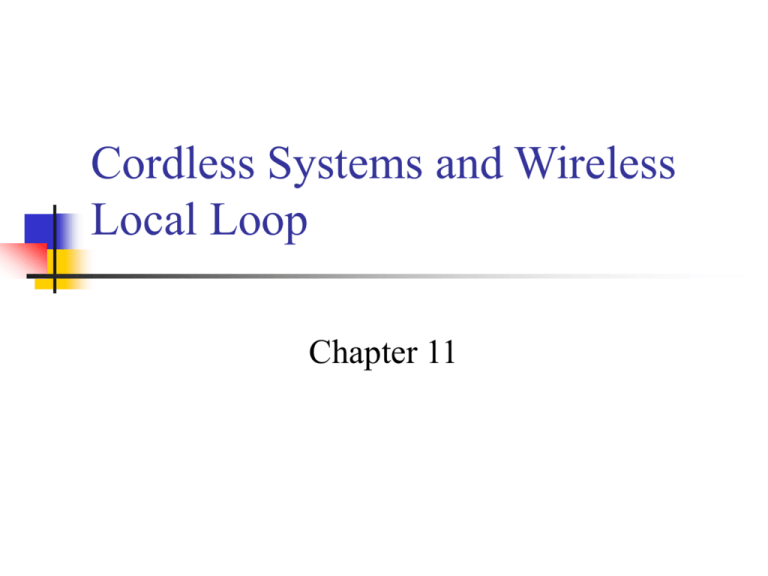
Cordless Systems and Wireless Local Loop Chapter 11 Cordless System Operating Environments Residential – a single base station can provide in-house voice and data support Office A single base station can support a small office Multiple base stations in a cellular configuration can support a larger office Telepoint – a base station set up in a public place, such as an airport Design Considerations for Cordless Standards Modest range of handset from base station, so low-power designs are used Inexpensive handset and base station, dictating simple technical approaches Frequency flexibility is limited, so the system needs to be able to seek a lowinterference channel whenever used Time Division Duplex (TDD) TDD also known as time-compression multiplexing (TCM) Data transmitted in one direction at a time, with transmission between the two directions Simple TDD TDMA TDD Simple TDD Bit stream is divided into equal segments, compressed in time to a higher transmission rate, and transmitted in bursts Effective bits transmitted per second: R = B/2(Tp+Tb+Tg) R = effective data rate B = size of block in bits Tp = propagation delay Tb = burst transmission time Tg = guard time Simple TDD Actual data rate, A: A = B /Tb Combined with previous equation: Tp Tg A 2 R1 Tb The actual data rate is more than double the effective data rate seen by the two sides TDMA TDD Wireless TDD typically used with TDMA A number of users receive forward channel signals in turn and then transmit reverse channel signals in turn, all on same carrier frequency Advantages of TDMA/TDD: Improved ability to cope with fast fading Improved capacity allocation DECT Frame Format Preamble (16 bits) – alert receiver Sync (16 bits) – enable receiver to synchronize on beginning of time slot A field (64 bits) – used for network control B field (320 bits) – contains user data X field (4 bits) – parity check bits Guard (60 bits) – guard time, Tg A Field Logical Control Channels Q channel – used to broadcast general system information from base station to all terminals P channel – provides paging from the base station to terminals M channel – used by terminal to exchange medium access control messages with base station N channel – provides handshaking protocol C channel – provides call management for active connections B Field B field transmits data in two modes Unprotected mode - used to transmit digitized voice Protected mode - transmits nonvoice data traffic DECT Protocol Architecture DECT Protocol Architecture Physical layer – data transmitted in TDMA-TDD frames over one of 10 RF carriers Medium access control (MAC) layer – selects/ establishes/releases connections on physical channels; supports three services: Broadcast Connection oriented Connectionless Data link control layer – provides for the reliable transmission of messages using traditional data link control procedures Differential Quantization Speech signals tend not to change much between two samples Transmitted PCM values contain considerable redundancy Transmit difference value between adjacent samples rather than actual value If difference value between two samples exceeds transmitted bits, receiver output will drift from the true value Encoder could replicate receiver output and additionally transmit that difference Differential PCM (DPCM) Since voice signals change relatively slowly, value of kth sample can be estimated by preceding samples Transmit difference between sample and estimated sample Difference value should be less than difference between successive samples At the receiver, incoming difference value is added to the estimate of the current sample Same estimation function is used Adaptive Differential PCM (ADPCM) Improve DPCM performance using adaptive prediction and quantization Predictor and difference quantizer adapt to the changing characteristics of the speech Modules Adaptive quantizer Inverse adaptive quantizer Adaptive predictor ADPCM Encoder ADPCM Decoder Subject Measurement of Coder Performance Subjective measurements of quality are more relevant than objective measures Mean opinion score (MOS) – group of subjects listen to a sample of coded speech; classify output on a 5-point scale MOS scale is used in a number of specifications as a standard for quality Wireless Local Loop Wired technologies responding to need for reliable, high-speed access by residential, business, and government subscribers ISDN, xDSL, cable modems Increasing interest shown in competing wireless technologies for subscriber access Wireless local loop (WLL) Narrowband – offers a replacement for existing telephony services Broadband – provides high-speed two-way voice and data service WLL Configuration Advantages of WLL over Wired Approach Cost – wireless systems are less expensive due to cost of cable installation that’s avoided Installation time – WLL systems can be installed in a small fraction of the time required for a new wired system Selective installation – radio units installed for subscribers who want service at a given time With a wired system, cable is laid out in anticipation of serving every subscriber in a given area Propagation Considerations for WLL Most high-speed WLL schemes use millimeter wave frequencies (10 GHz to about 300 GHz) There are wide unused frequency bands available above 25 GHz At these high frequencies, wide channel bandwidths can be used, providing high data rates Small size transceivers and adaptive antenna arrays can be used Propagation Considerations for WLL Millimeter wave systems have some undesirable propagation characteristics Free space loss increases with the square of the frequency; losses are much higher in millimeter wave range Above 10 GHz, attenuation effects due to rainfall and atmospheric or gaseous absorption are large Multipath losses can be quite high Fresnel Zone How much space around direct path between transmitter and receiver should be clear of obstacles? Objects within a series of concentric circles around the line of sight between transceivers have constructive/destructive effects on communication For point along the direct path, radius of first Fresnel zone: R SD SD S = distance from transmitter D = distance from receiver Atmospheric Absorption Radio waves at frequencies above 10 GHz are subject to molecular absorption Peak of water vapor absorption at 22 GHz Peak of oxygen absorption near 60 GHz Favorable windows for communication: From 28 GHz to 42 GHz From 75 GHz to 95 GHz Effect of Rain Attenuation due to rain Presence of raindrops can severely degrade the reliability and performance of communication links The effect of rain depends on drop shape, drop size, rain rate, and frequency Estimated attenuation due to rain: A aR b A = attenuation (dB/km) R = rain rate (mm/hr) a and b depend on drop sizes and frequency Effects of Vegetation Trees near subscriber sites can lead to multipath fading Multipath effects from the tree canopy are diffraction and scattering Measurements in orchards found considerable attenuation values when the foliage is within 60% of the first Fresnel zone Multipath effects highly variable due to wind Multipoint Distribution Service (MDS) Multichannel multipoint distribution service (MMDS) Also referred to as wireless cable Used mainly by residential subscribers and small businesses Local multipoint distribution service (LMDS) Appeals to larger companies with greater bandwidth demands Advantages of MMDS MMDS signals have larger wavelengths and can travel farther without losing significant power Equipment at lower frequencies is less expensive MMDS signals don't get blocked as easily by objects and are less susceptible to rain absorption Advantages of LMDS Relatively high data rates Capable of providing video, telephony, and data Relatively low cost in comparison with cable alternatives 802.16 Standards Development Use wireless links with microwave or millimeter wave radios Use licensed spectrum Are metropolitan in scale Provide public network service to fee-paying customers Use point-to-multipoint architecture with stationary rooftop or tower-mounted antennas 802.16 Standards Development Provide efficient transport of heterogeneous traffic supporting quality of service (QoS) Use wireless links with microwave or millimeter wave radios Are capable of broadband transmissions (>2 Mbps) IEEE 802.16 Protocol Architecture Protocol Architecture Physical and transmission layer functions: Encoding/decoding of signals Preamble generation/removal Bit transmission/reception Medium access control layer functions: On transmission, assemble data into a frame with address and error detection fields On reception, disassemble frame, and perform address recognition and error detection Govern access to the wireless transmission medium Protocol Architecture Convergence layer functions: Encapsulate PDU framing of upper layers into native 802.16 MAC/PHY frames Map upper layer’s addresses into 802.16 addresses Translate upper layer QoS parameters into native 802.16 MAC format Adapt time dependencies of upper layer traffic into equivalent MAC service IEEE 802.16.1 Services Digital audio/video multicast Digital telephony ATM Internet protocol Bridged LAN Back-haul Frame relay IEEE 802.16.3 Services Voice transport Data transport Bridged LAN IEEE 802.16.1 Frame Format IEEE 802.16.1 Frame Format Header - protocol control information Downlink header – used by the base station Uplink header – used by the subscriber to convey bandwidth management needs to base station Bandwidth request header – used by subscriber to request additional bandwidth Payload – either higher-level data or a MAC control message CRC – error-detecting code MAC Management Messages Uplink and downlink channel descriptor Uplink and downlink access definition Ranging request and response Registration request, response and acknowledge Privacy key management request and response Dynamic service addition request, response and acknowledge MAC Management Messages Dynamic service change request, response, and acknowledge Dynamic service deletion request and response Multicast polling assignment request and response Downlink data grant type request ARQ acknowledgment Physical Layer – Upstream Transmission Uses a DAMA-TDMA technique Error correction uses Reed-Solomon code Modulation scheme based on QPSK Physical Layer – Downstream Transmission Continuous downstream mode For continuous transmission stream (audio, video) Simple TDM scheme is used for channel access Duplexing technique is frequency division duplex (FDD) Burst downstream mode Targets burst transmission stream (IP-based traffic) DAMA-TDMA scheme is used for channel access Duplexing techniques are FDD with adaptive modulation, frequency shift division duplexing (FSDD), time division duplexing (TDD)
